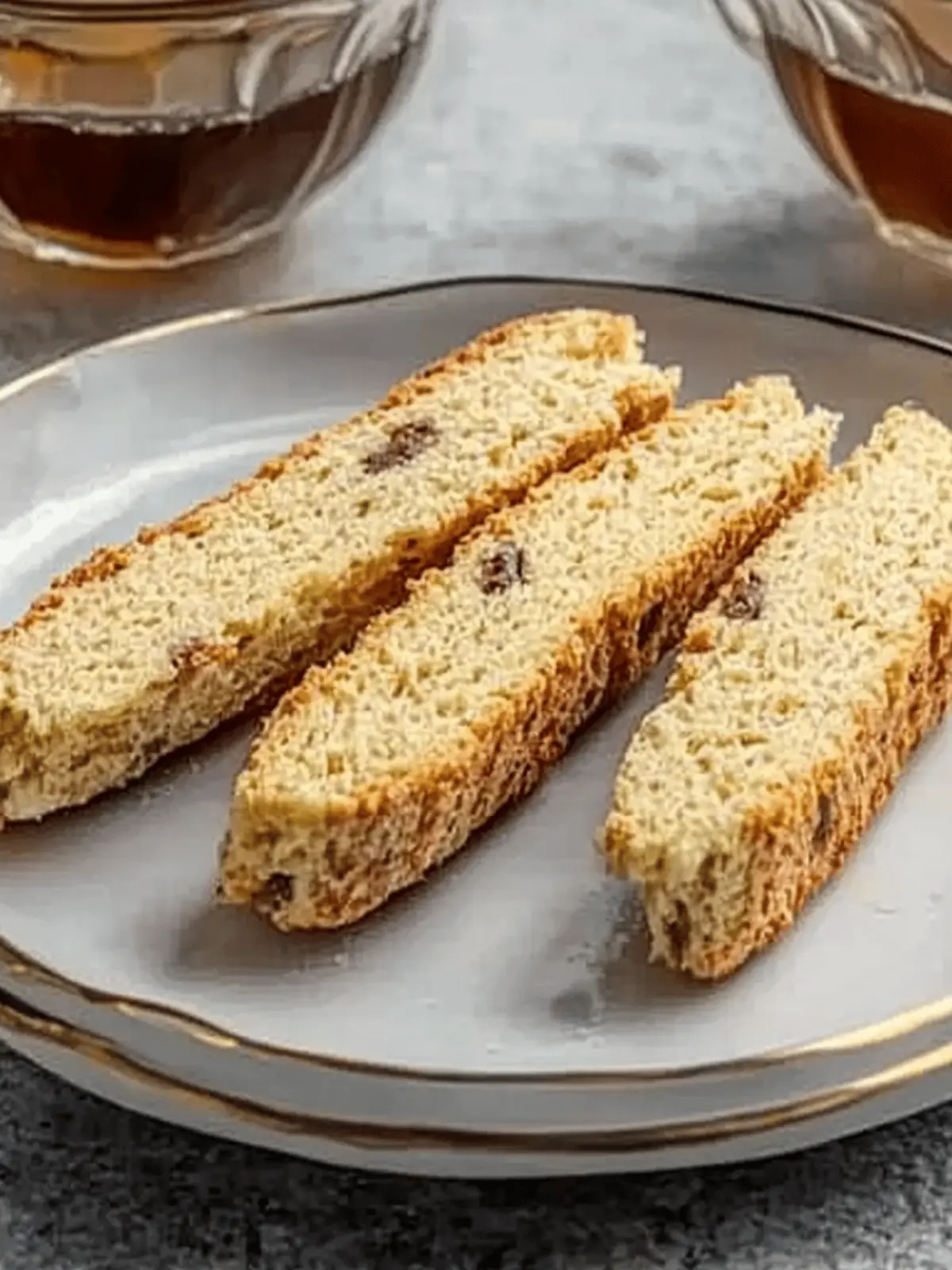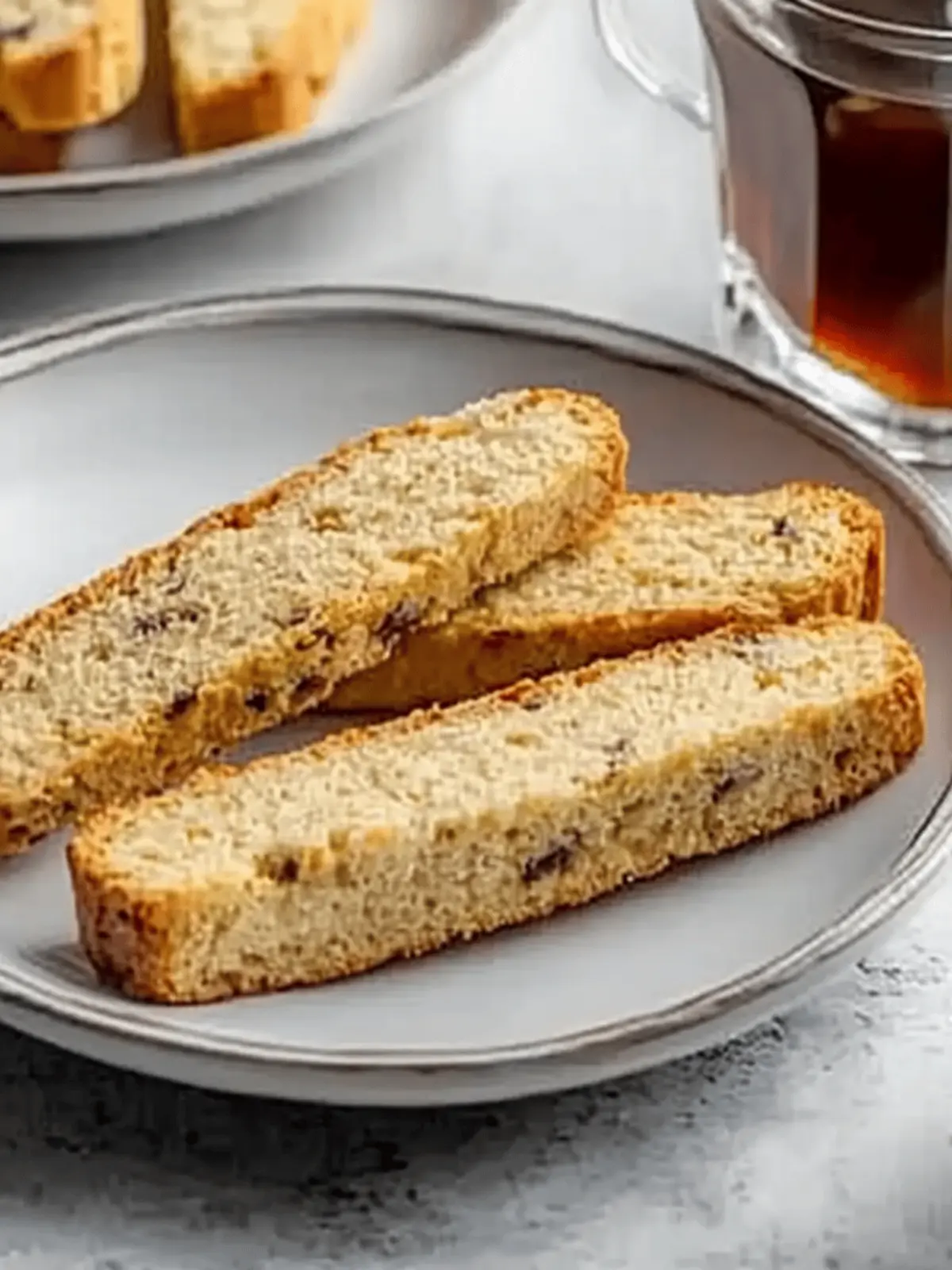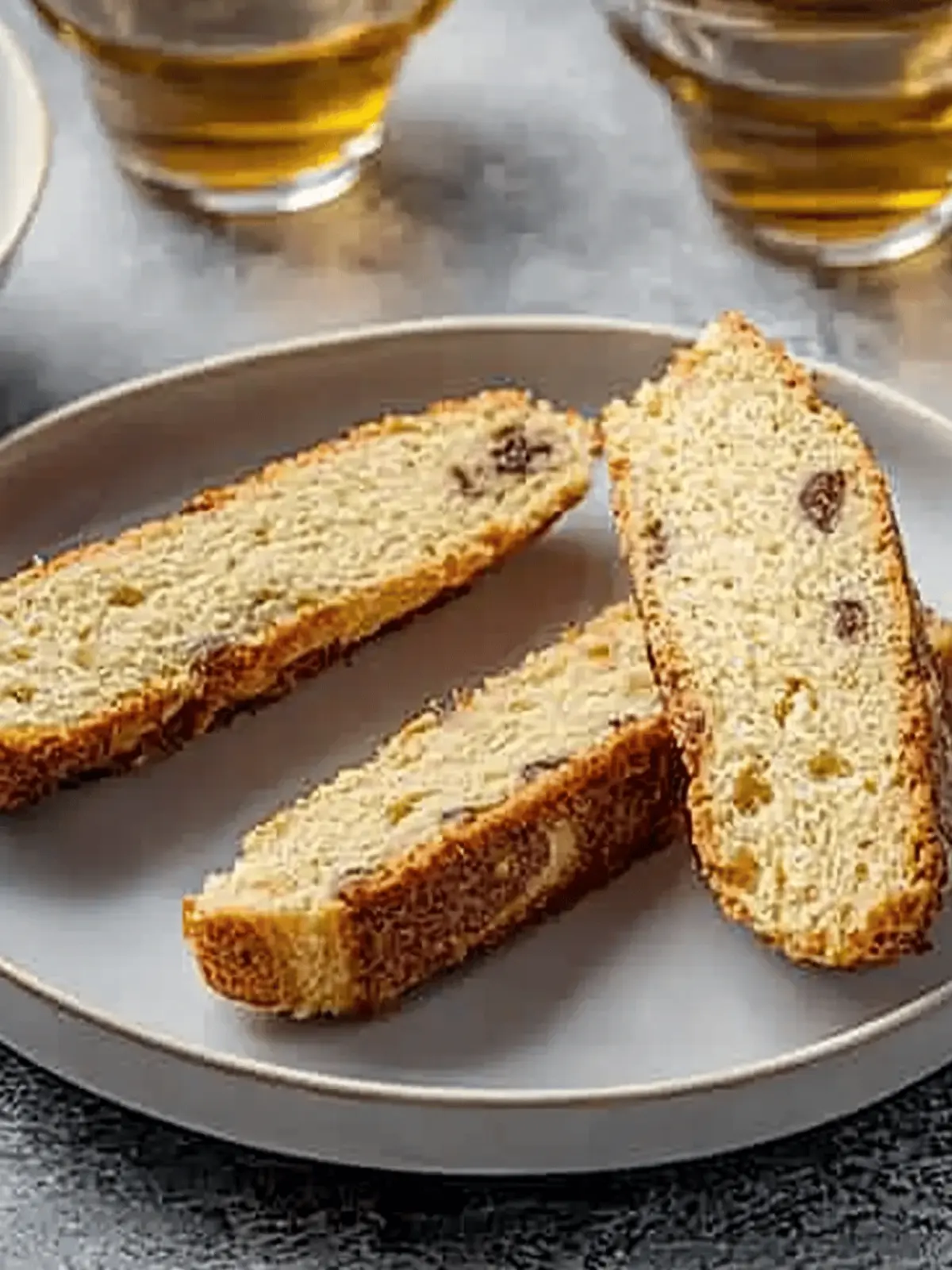There’s a certain comfort that comes from the crunch of a perfectly baked biscotti, especially when enjoyed with a steaming cup of coffee or tea. I discovered this classic almond biscotti recipe one rainy afternoon while trying to bring a bit of sweetness to my day. The aroma of toasted almonds filled my kitchen, instantly lifting my spirits. With just a handful of simple ingredients, this twice-baked treat not only offers a delightful crunch but also invites endless variations—think chocolate chips, caramel pieces, or even a hint of espresso for a morning boost.
If you’re on a quest to break free from mundane fast food and crave homemade goodness, this biscotti will become your new go-to. Deliciously versatile, it allows you to explore flavors and textures, so get ready to indulge in the satisfying journey of baking your very own biscotti. Let’s dive into this delightful recipe that is surprisingly simple yet impressively sophisticated!
Why is biscotti the ultimate treat?
Deliciously versatile: This biscotti opens doors to endless flavor experiments, from classic almond to luscious chocolate chip.
Easy to make: With a simple process, anyone can whip up a batch, making it perfect for novice bakers and seasoned chefs alike.
Perfect for pairing: Enjoy it alongside your favorite coffee or tea, making each bite a delightful experience.
Great for sharing: Biscotti makes for a thoughtful homemade gift that will charm friends and family.
Long-lasting crunch: Its twice-baked nature keeps it fresh and crunchy, making it a reliable treat for weeks to come.
Experience the joy of homemade biscotti today!
Biscotti Ingredients
- For the Dough
• Butter – Adds richness and moisture to the biscotti; margarine can be used for a dairy-free option.
• Sugar – Provides sweetness and contributes to a crispy texture; feel free to substitute with sugar alternatives for lower-calorie options.
• Eggs – Bind ingredients and create a tender texture; try flax eggs for a vegan substitute.
• Anise Extract – Infuses a distinctive flavor; vanilla extract offers a neutral alternative.
• All-Purpose Flour – Gives structure to the biscotti; for a gluten-free alternative, almond flour can be used, though adjustments in ratios may be necessary.
• Baking Powder – Responsible for leavening, yielding a light texture.
• Chopped Almonds – Enhance nuttiness and crunch; only use pecans or walnuts for a unique flavor twist. - For the Finishing Touch
• Milk – Brushed on the dough’s surface creates a beautiful golden finish before baking.
Dive into the delightful process of making your own biscotti!
How to Make Biscotti
-
Prep: Preheat your oven to 375°F (190°C). In a large mixing bowl, cream together the butter and 1 cup of sugar until the mixture is light and fluffy, which should take about 5-7 minutes. Beat in the eggs one at a time, thoroughly mixing each in, and then stir in the anise extract for that delicious flavor.
-
Combine Dry Ingredients: In a separate bowl, whisk together the all-purpose flour, baking powder, and a pinch of salt. This mixture will bring structure to your biscotti.
-
Mix: Gradually add the dry ingredients to the wet mixture, mixing until just combined. Fold in the chopped almonds gently, ensuring they’re evenly distributed throughout.
-
Shape and Bake: Divide the dough into two equal halves, shaping each into a 12×3-inch rectangle on a greased baking sheet. Brush the tops with milk and sprinkle the remaining sugar over them for a sweet finish. Bake for 15-20 minutes, or until they’re golden brown and firm to the touch.
-
Cool: After baking, remove the biscotti from the oven and allow them to cool on a wire rack for about 15 minutes. Lower the oven temperature to 300°F (150°C) while you wait.
-
Slice: Once cooled, use a serrated knife to slice the rectangles diagonally into ½-inch pieces. Place these slices cut-side down on ungreased baking sheets for the next step.
-
Second Bake: Return the biscotti to the oven and bake for another 10 minutes. Then flip the slices and bake for an additional 10 minutes until firm. Let them cool completely on wire racks before enjoying.
Optional: Drizzle melted chocolate over the cooled biscotti for an extra sweet treat.
Exact quantities are listed in the recipe card below.
Biscotti Variations & Substitutions
Feel free to unleash your creativity and tweak this biscotti recipe to match your taste buds—there’s no wrong way to enjoy these delightful treats!
-
Chocolate Chip: Add ½ cup of chocolate chips to the dough for a rich, gooey texture. The melty chocolate contrasts beautifully with the crunchy biscotti.
-
Nutty Twist: Substitute chopped almonds with walnuts, pistachios, or pecans for a unique flavor burst. Different nuts bring diverse flavors and textures to every bite!
-
Citrus Zest: Incorporate a teaspoon of orange or lemon zest into the dough for a refreshing citrusy kick. This airy note pairs wonderfully with coffee or tea.
-
Gluten-Free: Replace all-purpose flour with almond flour or a gluten-free blend. Keep an eye on the moisture levels, as adjustments may be needed for delightful crunchiness.
-
Spiced Delight: Mix in 1 teaspoon of cinnamon or cardamom to the dough for a warm spice flavor. These spices add a comforting aroma that’s perfect for cozy afternoons.
-
Dried Fruit: Stir in up to ½ cup of chopped dried cherries or apricots for a sweet, chewy contrast. The fruity notes balance the biscotti’s crispiness beautifully.
-
Espresso Boost: Add 2 tablespoons of instant espresso powder to the batter for a caffeinated kick. This twist elevates your biscotti to the next level—perfect for coffee lovers!
With these variations, your biscotti experience transitions from classic to unforgettable, offering new temptations with every batch. Happy baking!
Tips for the Best Biscotti
- Cool Completely: Let biscotti cool entirely before storing; this preserves their signature crunchiness and prevents sogginess.
- Serrated Knife: Use a serrated knife for slicing; it helps achieve clean cuts without crumbling your beautifully baked biscotti.
- Experiment with Flavors: Don’t hesitate to add your favorite extras like chocolate chips or dried fruits; just remember the focus on balance to maintain the biscuit structure!
- Watch the Bake Time: Keep an eye on your second bake; each oven varies, and you want them perfectly firm yet not overbaked.
- Moisture Considerations: If using almond flour, remember to adjust ratios as it may absorb more moisture than all-purpose flour, ensuring your biscotti stay delightful.
Make Ahead Options
These classic biscotti are perfect for meal prep enthusiasts! You can prepare the dough up to 24 hours in advance and refrigerate it. Simply follow the initial steps of creaming the butter and sugar, adding the eggs, and mixing in the dry ingredients. To maintain quality, wrap the dough tightly in plastic wrap to prevent drying out. When you’re ready to bake, just shape the dough into rectangles and proceed with the baking instructions. If you prefer a longer storage option, baked biscotti can be kept in an airtight container at room temperature for about a week or frozen for up to 2 months. Enjoy the convenience of homemade biscotti without the last-minute rush!
What to Serve with Biscotti?
Pairing the perfect treats with your delicious biscotti will elevate your snack time into a delightful experience.
- Rich Espresso: A bold cup of espresso wonderfully contrasts the sweet crunchiness of biscotti, creating a pairing that awakens your taste buds.
- Creamy Hot Chocolate: The lusciousness of hot chocolate complements biscotti’s texture, making it a comforting choice for cozy evenings.
- Fresh Berries: Juicy, tart berries add a refreshing element to balance the biscotti’s sweetness while introducing vibrant flavors.
- Nutty Granola: A crunchy granola mix adds a delightful texture and divine nuttiness that mirrors the almonds in your biscotti.
- Classic Almond Milk: Sipping on smooth almond milk enhances the nutty essence of biscotti, making every bite a harmonious experience.
- Cheese Platter: A soft cheese, like brie or goat cheese, pairs beautifully with biscotti, providing a sophisticated balance of flavors.
- Sweet Dipping Sauce: A drizzle of caramel or chocolate sauce invites a playful element, enhancing the overall treat experience.
Embrace these pairings for a memorable and indulgent treat!
Storage Tips for Biscotti
- Room Temperature: Store biscotti in an airtight container at room temperature for up to one week; this maintains their delightful crunch and flavor.
- Freezer: For long-term storage, wrap biscotti in plastic wrap and place them in a freezer-safe container. They can be frozen for up to two months and will retain their quality.
- Thawing: When ready to enjoy, simply remove from the freezer and let them sit at room temperature for about 30 minutes before serving.
- Reheating: If you prefer your biscotti warm, you can reheat them in a preheated oven at 300°F (150°C) for about 10 minutes for that fresh-baked crunch!
Biscotti Recipe FAQs
What type of almonds should I use for biscotti?
I recommend using blanched almonds for a smoother texture in your biscotti. However, you can also use slivered or chopped almonds based on your preference. Peanuts and walnuts work well for added crunch and flavor, too!
How should I store my biscotti to keep them fresh?
Store your biscotti in an airtight container at room temperature for about one week. To prevent them from becoming stale, make sure they are completely cool before sealing them up. If you’re not planning to enjoy them within that timeframe, freezing is a great option!
Can I freeze biscotti, and if so, how?
Absolutely! To freeze your biscotti, wrap them tightly in plastic wrap and place them in a freezer-safe container. They can stay fresh for up to two months. When you’re ready to enjoy, just take them out and let them sit at room temperature for about 30 minutes. If you’d like them warm, give them a quick reheat in a preheated oven at 300°F (150°C) for about 10 minutes.
What should I do if my biscotti turn out too hard?
If your biscotti are too hard, it could be due to overbaking. Keep an eye on them during the second bake to ensure they don’t go too far beyond golden. Alternatively, you can try storing them in an airtight container with a slice of bread to add some moisture back in; just be cautious not to let them soak and become soggy!
Can pets eat biscotti?
It’s best to keep biscotti away from pets due to ingredients like sugar and certain flavorings that may be harmful. If you’re looking for a pet-friendly treat, consider making a simple dog biscuit recipe specifically designed for them!
Is there a gluten-free option for biscotti?
Yes, you can substitute the all-purpose flour with almond flour for a gluten-free version. However, note that almond flour has different moisture absorption properties, so you might need to experiment with the ratios. Start with about 1 to 1.5 cups of almond flour and adjust as necessary to achieve the right dough consistency.
If you have more questions about the biscotti recipe, feel free to ask!

Delicious Biscotti: Classic Crunch with Creative Twists
Ingredients
Equipment
Method
- Preheat your oven to 375°F (190°C). In a large mixing bowl, cream together the butter and 1 cup of sugar until light and fluffy, about 5-7 minutes. Beat in the eggs one at a time, thoroughly mixing each in, and then stir in the anise extract.
- In a separate bowl, whisk together the all-purpose flour, baking powder, and a pinch of salt.
- Gradually add the dry ingredients to the wet mixture, mixing until just combined. Fold in the chopped almonds gently.
- Divide the dough into two equal halves, shaping each into a 12x3-inch rectangle on a greased baking sheet. Brush the tops with milk and sprinkle with remaining sugar.
- Bake for 15-20 minutes, until golden brown and firm to the touch.
- Remove from the oven and allow to cool on a wire rack for about 15 minutes. Lower the oven temperature to 300°F (150°C).
- Once cooled, slice the rectangles diagonally into ½-inch pieces. Place cut-side down on ungreased baking sheets.
- Return to the oven and bake for another 10 minutes. Flip the slices and bake for an additional 10 minutes until firm. Cool completely on wire racks.








